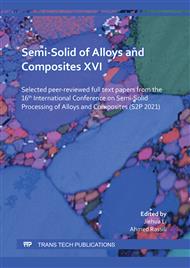[1]
D. Nestler, Beitrag zum Thema Verbundwerkstoffe - Werkstoffverbunde: Status quo und Forschungsansätze,, Technische Universität Chemnitz, (2012).
Google Scholar
[2]
F. Scherm et al., Microstructural characterization of interpenetrating light weight metal matrix composites,, Materials Science and Engineering A, vol. 518, p.118–123, (2009).
DOI: 10.1016/j.msea.2009.04.010
Google Scholar
[3]
R.J. Moon, M. Tilbrook, M. Hoffman and A. Neubrand, Al-Al 2O 3 composites with interpenetrating network structures: Composite modulus estimation,, Journal of the American Ceramic Society, vol. 88, no. 3, p.666–674, (2005).
DOI: 10.1111/j.1551-2916.2005.00115.x
Google Scholar
[4]
C. San Marchi, M. Kouzeli, R. Rao, J.A. Lewis and D.C. Dunand, Alumina-aluminum interpenetrating-phase composites with three-dimensional periodic architecture,, Scripta Materialia, vol. 49, no. 9, p.861–866, (2003).
DOI: 10.1016/s1359-6462(03)00441-x
Google Scholar
[5]
D. Cree and M. Pugh, Production and characterization of a three-dimensional cellular metal-filled ceramic composite,, Journal of Materials Processing Technology, vol. 210, p.1905–1917, (2010).
DOI: 10.1016/j.jmatprotec.2010.07.002
Google Scholar
[6]
J. Binner, H. Chang and R. Higginson, Processing of ceramic-metal interpenetrating composites,, Journal of the European Ceramic Society, (2009).
DOI: 10.1016/j.jeurceramsoc.2008.07.034
Google Scholar
[7]
G. Standke, T. Müller, A. Neubrand, J. Weise and R. Westerheide, Metall-Matrix-Verbundwerkstoffe auf Basis von Hochleistungs- Schaumkeramiken,, (2005).
Google Scholar
[8]
C. Seyboldt, M. Liewald and D. Heydt, Production of Aluminium Based Interpenetrating Phase Composites Using Semi-Solid Forming,, Key Engineering Materials, vol. 716, p.502–509, (2016).
DOI: 10.4028/www.scientific.net/kem.716.502
Google Scholar
[9]
L. Schomer and M. Liewald, Structural Characteristics of Metal-Ceramic Interpenetrating Phase Composites Manufactured by Using Semi-Solid Forming Technology,, Solid State Phenomena, vol. 285, p.51–56, (2019).
DOI: 10.4028/www.scientific.net/ssp.285.51
Google Scholar
[10]
L. Schomer and M. Liewald, Design of Semi-Solid Forming Tools for Producing Metal-Ceramic Interpenetrating Phase Composites,, Procedia Manufacturing, vol. 47, p.1004–1009, (2020).
DOI: 10.1016/j.promfg.2020.04.308
Google Scholar
[11]
L. Schomer, M. Kütemeyer and M. Liewald, Interface Reactions Occurring in Metal-Ceramic Interpenetrating Phase Composites Manufactured by Using Semi-Solid Forming Technology,, Advanced Composites and Hybrid Materials, vol. 3, no. 2, p.222–230, May (2020).
DOI: 10.1007/s42114-020-00152-6
Google Scholar
[12]
Deutsches Institut für Normung e.V., DIN EN 658-3:2002: Raumtemperatur, Mechanische Eigenschaften von keramischen Verbundwerkstoffen bei Biegefestigkeit; Teil 3: Bestimmung der,, Berlin: Beuth Verlag, (2002).
DOI: 10.31030/9126917
Google Scholar
[13]
Deutsches Institut für Normung e.V., DIN EN ISO 3327:2009: Hartmetalle – Bestimmung der Biegebruchfestigkeit,, Berlin: Beuth Verlag, (2009).
DOI: 10.31030/1500054
Google Scholar
[14]
D. Hardy and D.J. Green, Mechanical Properties of a Partially Sintered Alumina,, Journal of the European Ceramic Society, vol. 15, no. 8, p.769–775, (1995).
DOI: 10.1016/0955-2219(95)00045-v
Google Scholar
[15]
M. Amne Elahi and S.G. Shabestari, Effect of various melt and heat treatment conditions on impact toughness of A356 aluminum alloy,, Transactions of Nonferrous Metals Society of China (English Edition), vol. 26, no. 4, p.956–965, (2016).
DOI: 10.1016/s1003-6326(16)64191-2
Google Scholar


